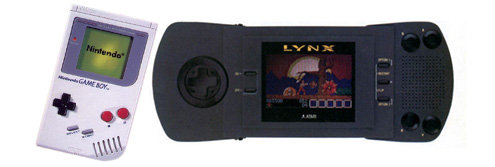PSP似で、ゲームボーイに負け、3DSで復活……ゲームギアの歴史

ComputerAndVideoGames.comに掲載された「History Lesson: Game Gear」が、とても興味深い記事でした。
ゲームギアは、1990年にセガから発売された携帯ゲーム機。本記事では、PSPとの類似点(若干強引ですが)や内部設計の考え方など、現在にも通じる話が書かれています。何より、20年前にこのような「携帯ゲーム戦争」がすでに起きていたことに(もしかすると、セガが携帯ゲーム機を発売していたことにさえ)驚く人も少なくないのではないでしょうか。
この歴史を踏まえると、3DSでの“復活”がドラマチックに見えてくる気がします。
以下、引用します。
ゲームギアの歴史 ─ 短距離ランナーの孤独
様々な意味で、セガのゲームギアはプレイステーション・ポータブルの“スピリチュアルな前任者”(そんな言葉があればの話だけど)だった。携帯ゲーム市場を支配する任天堂と戦うために、1990年のセガと2004年のソニーの両者は、決定的な2つの戦略を持っていた。圧倒的なグラフィックの力と、クールなブランディングだ。14年を隔てた2台のゲーム機には共通点が多い。韻を踏んだ名称。流線型で持ちやすいランドスケープ型デザイン。女の子お断りの本体カラー(注:初代PSPは黒のみだった)。ライバルである任天堂のゲーム機を「おもちゃ」にするために画策された、マルチメディアの拡張性(ゲームギアも外付けチューナーを付けるとテレビになった)。もちろん、同世代機を蹴散らす高いスペックも(共通している)。
History Lesson: Game Gear
The loneliness of the short-distance runner...
In many ways, the Sega Game Gear was the spiritual predecessor (if there is such a thing) to the PlayStation Portable. Both the Sega of 1990 and the Sony of 2004 thought they had the ultimate two-pronged strategy to combat Nintendo's dominance of the handheld market: out-muscle them with sheer graphical force and ice-cool branding.
Thus the two consoles, 14 years apart, had much in common. Alliterative names that oozed adult credibility. Sleek and comfortable landscape designs. The kind of dark, brooding colour schemes that cause young maidens to faint.
A focus on multimedia capabilities (the Game Gear's TV Tuner add-on transformed it into a portable telly), which was orchestrated largely to make the rival Nintendo consoles seem like toys in comparison. And of course, tech specs that blew their contemporaries away.
マッド・ギア
その結果、こうした類似点は当然のごとく両者に悲劇をもたらした。彼らの最新型ディスプレイは、デモ機では美しく見えたかもしれない。しかしその時点では野心的すぎて、多くの問題を引き起こすことになった。MAD GEAR
And so, unsurprisingly given their similarities, both consoles fell on the same sword. Their cutting-edge displays might have looked good in demo pods, but they were overly ambitious for their time and this led to a host of problems.
それらの問題には価格も含まれていた(ゲームギアは当時145英ポンド、明らかにゲームボーイより高価だった)(注:米国でのゲームギアの初期価格は$150、ゲームボーイは$89.99だった)。さらに致命的なのは、救いがたいバッテリーライフだ。ゲームギアの、バッテリーへの底知れぬ渇望はもはや伝説である。6本の単3電池をわずか3時間で飲み干してしまうのだ。
These woes included the price (at £145, the Game Gear was significantly more expensive than the Game Boy) and, most crucially, an abysmal battery life. The Game Gear's unquenchable thirst for power was legendary: it could suck six AA batteries dry in a little over three hours.
対するゲームボーイのバッテリーの持ちはほぼ10倍。ゲームボーイユーザーが外でゲームを楽しんでいる間、世界中のゲームギアがACアダプタとともに家で留守番をするようになるまで、そう時間はかからなかった。
The Game Boy could manage nearly ten times that. It wasn't long before the world's Game Gears were left at home with their AC adapters while their owners frolicked outside with their Game Boys.
ゲームギアの世界販売台数である1,100万という数字は、6,400万台のゲームボーイに比べれば小さいかもしれない。しかし、競争の激しい携帯ゲーム機市場で2位を獲得した数字としては十分なものであった。
The Game Gear's worldwide sales figure of 11 million might have been dwarfed by the Game Boy's 64 million, but it was enough to put it in second place in the most competitive handheld market there has ever been.
“黄”熱病

ゲームボーイは、1990年10月6日に日本でゲームギアが発売された時点で、その黄色がかったモノクロの画面にもかかわらず、すでにフルカラーのライバルたち─たとえばアタリのリンクスなど─を殲滅していた。
YELLOW FEVER
Despite its monochrome display and yellow screen, the Game Boy was already wiping the floor with full-colour rivals such as the Atari Lynx when the Game Gear finally launched in Japan on 6 October 1990.
たとえバッテリーライフと高いコストがリンクスの敗因の一部だったとしても、最大の要因はソフトの品揃えでゲームボーイに対抗すべきだったのにそれができなかったということだろう。『テトリス』と『ループス』は(どちらが良い)? 『スーパーマリオランド』と『ダイノリンピックス』は? 争う余地もない。
Although battery life and cost were also factors in the Lynx's demise, the perception was that it just didn't have the game library required to mount a meaningful challenge against the Game Boy. Tetris or Loopz? Super Mario Land or Dinolympics? It wasn't even a contest.

ゲームギアの内部構造は、リンクスと同じ轍を踏まないように設計されていた。心臓部であるザイログZ-80プロセッサが、(当時の人気機種でソフトが豊富だった)セガの据え置き機・マスターシステムのものとほぼ同一だったこともあって、構造的にマスターシステムのソフトを「MASTER GEAR CONVERTER」(ゲームギアに取り付けるとマスターシステムのカートリッジがそのまま使えるアタッチメント)で遊ぶことも可能だった。
The Game Gear's innards were designed to ensure that Sega's handheld wouldn't suffer the same fate. At its heart, the Zilog Z80 processor was structurally almost identical to that which powered Sega's 8-bit home console, the Master System - so much so that it was capable of playing its back catalogue with the help of the Master Gear add-on.
開発者がこのCPUに慣れ親しんでいたこともあり、この設計はゲーム開発の費用対効果の向上をもたらした。当然、マスターシステムからの(安易な)移植作品が大量に殺到した(ゲームギアという棺を閉じるクギのひとつとなった)。とはいえ、その中の多くは小さな画面用にかなりの部分を作り直していたのだが。
This made it cost-efficient to develop for the system, since coders were already familiar with the chip. Naturally, this led to a large influx of Master System ports (another nail in the Game Gear's 209x111x37mm coffin), but a great many of them were reworked significantly for the small screen.
7年の間に、ゲームギアのために全部で363作品のゲームがリリースされたが、『テトリス』や『スーパーマリオランド』に匹敵するタイトルはついに現れなかった。ゲームギアのベストタイトルはそれらとは違うジャンルだった。プレイする価値のある専用ソフトは、『アックスバトラー ゴールデンアックス伝説』『アーリエル クリスタル伝説』など、一握りのマイナーな初期のタイトルに限定される。
In all, 363 games were released for the Game Gear over its seven-year life, but it never found its equivalents of Tetris or Super Mario Land; and its best games could be found in some form on another format. Worthwhile exclusives were limited to a handful of minor classics, such as Ax Battler and Crystal Warriors.
長きに渡るゲームギアの成功に影を落としたのは、ゲームギアのばかげたバッテリーライフだった。(イギリス発の飛行機が)フランスに到着する前にバッテリーが切れるというのに、32色を表示できるスクリーンに価値があるだろうか?
It was the Game Gear's absurd battery life that ultimately undermined any long-term success. Where's the value in having 32 colours on screen if you can no longer switch the thing on by the time your plane reaches France?
そしてその後、任天堂の技術力によって、ゲームギア自身の落ち度とは無関係に、ゲームギアのミニ・クラシックなゲームライブラリは葬り去られたのだった。
あれから20年の時を経て、同じ任天堂の技術によって、それらの作品が3DSで息を吹き返すのだ。新世代のゲーマーのために。

And so Nintendo's handheld expertise buried the Game Gear's library of forgotten mini-classics through no fault of their own. Two decades on, that same expertise will revive them on 3DS for a new generation of gamers.
元記事:
Spartacus Legends preview The bloodiest history lesson imaginable | GamesRadar+